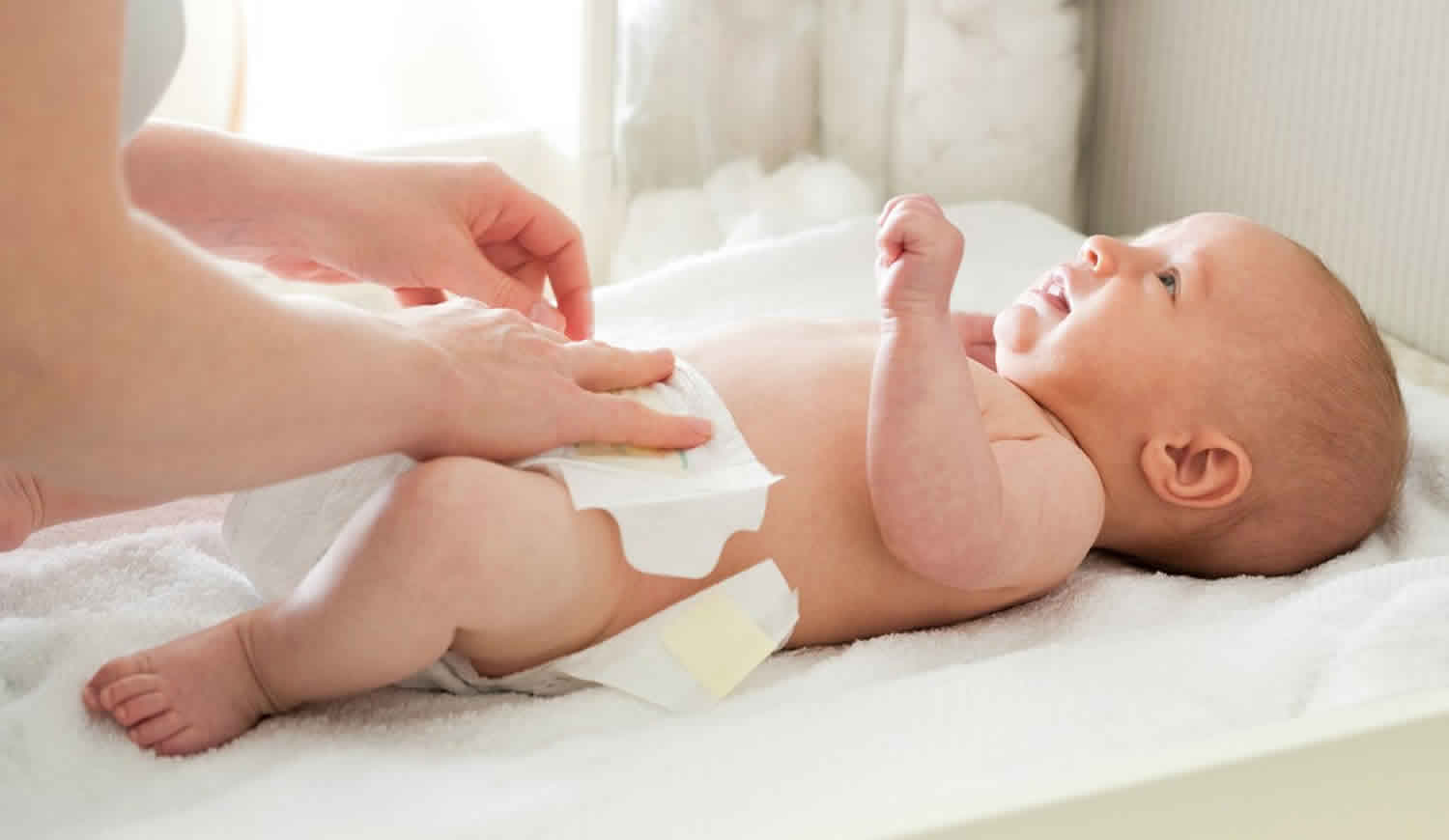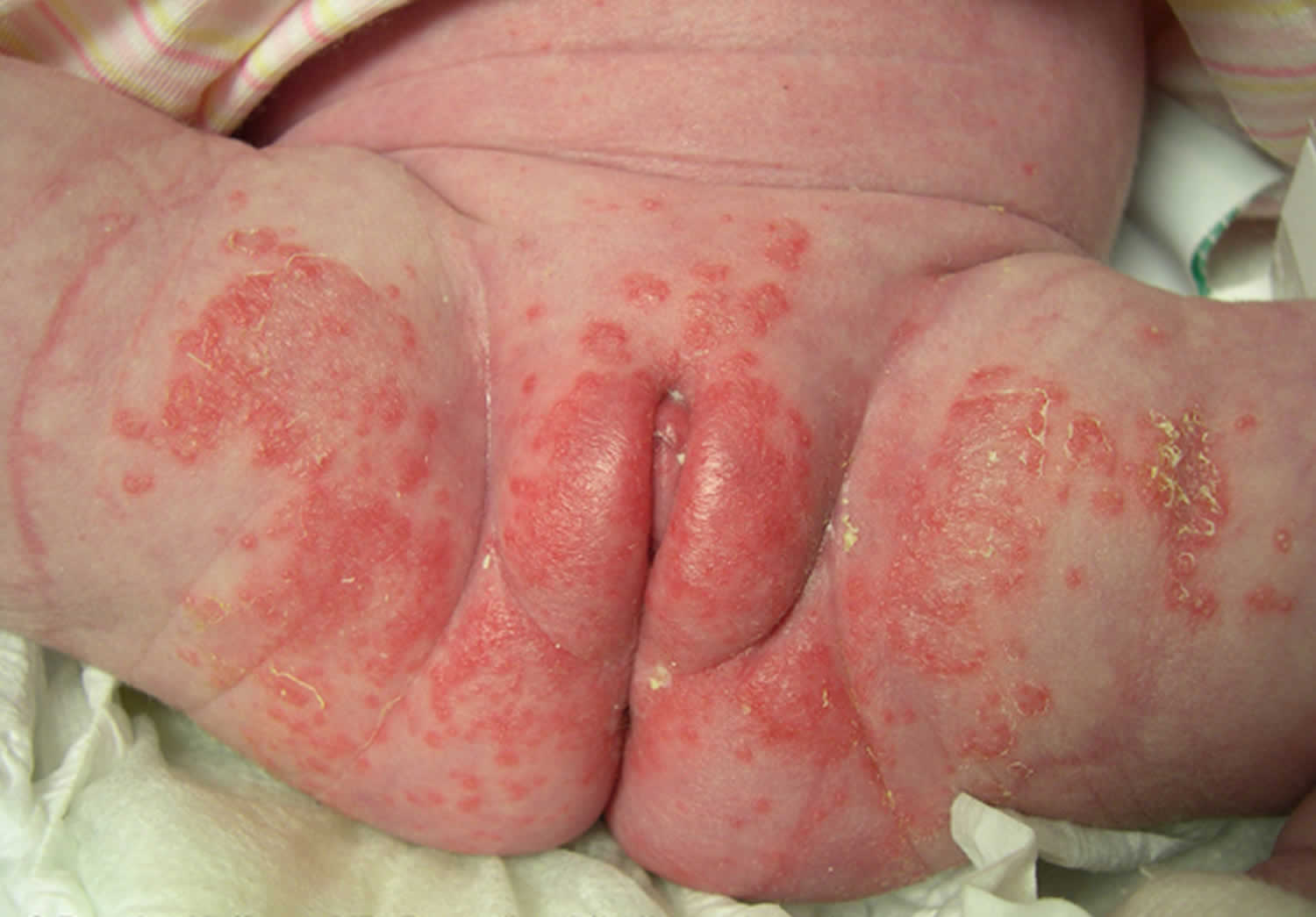Diaper dermatitis
Diaper dermatitis also called diaper rash or napkin dermatitis, is used to describe various skin conditions that affect the skin under a baby’s diaper. Diaper dermatitis is most often a form of contact dermatitis.
Diaper dermatitis most often affects babies aged 3 to 15 months of age (peaking at 9 to 12 months of age), especially those wearing traditional cloth diapers (50%). Diaper dermatitis is much less prevalent in babies wearing modern breathable and multilayered disposable diapers.
The infant’s anatomy can place them at higher risk, as many folds and creases in the diaper distribution can create a problem due to difficulty cleansing and a moist environment.
Diaper dermatitis can also affect older children and adults that are incontinent (incontinence-associated dermatitis).
Figure 1. Candidal diaper rash
Footnote: Diaper candidiasis – “beefy” red erythema with a raised, white scaly, sharply demarcated edge. The diagnostic hallmark is the presence of satellite lesions, both pustules and vesicles. Oral thrush may also be present.
Figure 2. Irritant contact diaper dermatitis
Footnote: Irritant contact dermatitis – erythema and scaling of the diaper region; a key to diagnosis is that irritant contact dermatitis routinely spares the intertriginous creases.
Figure 3. Contact diaper dermatitis (chafing dermatitis)
Footnote: Chafing dermatitis – mild erythema and scaling that comes and goes, appearing in areas of friction, i.e. abdomen, inner thighs, buttocks, and genitalia.
Rarely, diaper rash can be associated with more serious conditions. Go see your family doctor or a pediatric dermatologist if:
- The diaper rash is not improving after several days of careful attention to the instructions below.
- Blisters, pus bumps or open sores develop.
- There are bruises or evidence of bleeding in the area.
- Your child is in significant discomfort.
- The rash is spreading to other parts of your child’s body.
- Your child is losing weight, feverish or seems sick.
Diaper dermatitis causes
Diaper dermatitis follows damage to the normal skin barrier and is primarily a form of irritant contact dermatitis. Irritant contact dermatitis secondary to contact with an irritating substance, such as urine, feces, balms, and often enhanced by certain conditions, such as prolonged exposure or high concentration, sensitive skin, and increased moisture.
- Urine and occlusion lead to overhydration and skin maceration.
- Fecal bile salts and enzymes break down stratum corneum lipids and proteins.
- A mixture of urine and feces creates ammonium hydroxide, raising pH.
- The wet skin is colonized by micro-organisms, particularly candida.
- Mechanical friction from limb movement may increase discomfort.
- Pre-existing skin conditions such as atopic dermatitis or seborrheic dermatitis predispose a baby to diaper dermatitis.
Babies who are breastfed have a lower incidence of diaper dermatitis, as feces in breastfed babies have a lower pH than in formula-fed babies. As babies start to eat solid foods, the stool frequency and pH start to increase and diaper dermatitis occurs more often.
Other causes of diaper rashes include:
- Candida albicans or diaper candidiasis: the primary source is infected feces, as Candida albicans resides in the lower intestines of infants. Alterations in skin microbial flora and skin pH can also contribute to diaper dermatitis caused by infections, such as Candida albicans.
- Impetigo
- Infantile seborrheic dermatitis
- Atopic eczema
- Psoriasis
- Miliaria
- Acrodermatitis enteropathica
- Biotin responsive dermatosis
- Rare disorders.
Diaper dermatitis is NOT due to:
- Allergy to the diapers
- Toxins in the diapers
- Washing powders (unless these are not thoroughly removed by rinsing)
- Dermatophyte fungal infections (tinea).
Diaper dermatitis prevention
- Change diapers frequently.
- Use superabsorbent disposable diapers to keep the skin under the diaper as dry as possible.
- Wipes:
- Cleanse the skin gently rather than scrubbing. Do not overdo it. Too much cleaning can actually irritate the skin, particularly when harsh soaps or chemicals from wipes are involved.
- Soft cloths moistened with plain water are the gentlest because they do not contain chemicals.
- If you choose packaged wipes, choose wipes that are alcohol-free, fragrance-free, and free of essential oils.
- Barrier diaper creams, pastes and ointments:
- A diaper cream, paste or ointment is called a barrier cream because it protects the skin from urine and stool. If you apply a diaper cream to your hand and wash your hand, you will notice the water beads up and does not get to your skin. In the same way, the diaper cream will protect your baby’s skin from urine and stool.
- Choose only products that are fragrance-free.
- Apply thick amounts of a diaper cream to the skin to protect the area after every diaper change. You do not need to clean off cream left on the skin if the child has not stooled.
- A cream or paste containing zinc oxide (thick and white) is often the best barrier.
- A plain white petroleum jelly or ointment is another good barrier.
- To wipe off the sticky diaper cream when the child is soiled, it helps to use mineral oil on a cotton ball.
- A daily short bath in lukewarm water helps to prevent skin breakdown. Use only gentle cleansers that are fragrance-free. Avoid bubble bath.
Diaper dermatitis signs and symptoms
Diaper dermatitis presents as erythematous macules and papules in the genital area that can spread to involve the lower abdomen and thighs.
- Irritant diaper dermatitis: well-demarcated variable erythema, oedema, dryness and scaling. Affected skin is in contact with the wet diaper and tends to spare the skin folds.
- Chafing: erythema and erosions where the diaper rubs, usually on waistband or thighs.
- Granuloma gluteale infantum: red or purple nodules
- Candida albicans: erythematous papules and plaques with small satellite spots or superficial pustules.
- Impetigo (Staphylococcus aureus and Streptococcus pyogenes): irregular blisters and pustules.
- Infantile seborrheic dermatitis: cradle cap and bilateral salmon pink patches, often desquamating, in skin folds.
- Atopic dermatitis: bilateral scratched, dry plaques anywhere, but uncommon in the nappy area and family history is common.
- Psoriasis: persistent, well-circumscribed, symmetrical, shiny, red, scaly or macerated plaques; other sites may be involved; family history common.
- Disseminated secondary eczema or autoeczematization: rash in distal sites associated with severe diaper rash.
Diaper dermatitis may predispose the infant to urinary tract infection and in females, to vaginal infection.
Diaper dermatitis diagnosis
Diaper dermatitis is diagnosed clinically. In most cases, no laboratory tests are necessary. Skin swabs may be useful to confirm Candida albicans or bacterial infection.
Diaper dermatitis treatment
The need to keep baby dry and use barrier creams should be emphasized. Caregivers should always wash their hands before and after changing a nappy/diaper. Diaper dermatitis is much less common with modern disposable diapers than with cloth diapers.
Disposable diapers:
- It is important to use superabsorbent disposable diapers and not cloth diapers when there is a diaper rash.
- Sometimes babies are allergic to the dyes in diapers. If your baby gets a lot of rashes, try switching to a plain white, dye-free, disposable diaper.
- Are available in different shapes and sizes depending on age and sex
- May be selected in a larger size to reduce contact and friction between the diaper and skin
- Keep the skin dry and clean
- Maintain optimal skin pH
- Should be changed when wet or soiled
- Contain cellulose pulp and superabsorbent polymers
- May include petrolatum-based moisturizing lotion to support the skin barrier
- Fasteners, backsheets and stretch reduce leakage
- Are non-toxic and biologically inert
- Do not contain allergens such as natural rubber latex or disperse dyes
- Lead to less household exposure to fecal matter.
If using cloth diapers, use diaper liners to keep the skin dry. Avoid plastic pants.
At diaper changes:
- Gently clean the baby’s skin with water and a soft cloth
- Wet wipes are convenient but expensive and can lead to contact allergy to preservatives used to stop them going mouldy
- Aqueous cream or another non-soap cleanser can be used if necessary
- Pat dry gently and allow to air dry
- Apply a protective emollient ointment containing petrolatum and zinc oxide.
Other suggestions:
- Give evening fluids early to reduce wetting at night.
- Observe whether certain foods are related to the rash by increasing stool acidity (eg, orange juice) or frequency. If this is the case, discontinue the responsible food, at least temporarily.
- Allow diaper-free times.
Wipes:
- It is best not to use packaged diaper wipes while your baby has a rash. Instead, use a soft white cloth with warm water to gently clean the skin. When changing diapers that only contain urine, simply pat the skin dry and reapply the barrier diaper cream.
- It is very important not to scrub the diaper area.
Prescription treatments
- Mild topical steroid such as hydrocortisone cream applied to inflamed skin once or twice daily for 1–2 weeks.
- Topical antifungal cream (eg, clotrimazole, ketoconazole, ciclopirox, sertaconazole) once or twice a day if suspicious of Candida albicans infection.
- Strong steroid creams should not be applied to a baby’s bottom, due to potential side effects of striae, tachyphylaxis and skin thinning.
- Non-prescription topical products containing aloe vera and Calendula officinalis are reportedly effective for diaper dermatitis.
Medicated creams:
- Common prescription creams for diaper rashes treat yeast like candida, bacteria like staph or strep, and redness.
- If your doctor prescribes a medicated cream to treat the diaper rash, apply it directly to the skin after cleaning the skin gently.
- Only use the medicated cream as often as your doctor tells you to. These usually need to be reapplied 2 or 3 times a day. If you are given a steroid cream (such as hydrocortisone) you should not use it more than the doctor recommends; this cream is usually used for only a week or two.
Barrier diaper creams:
- Apply a barrier cream (with zinc oxide or petroleum jelly) over the medicated cream. Use the barrier cream as many times a day as possible. You cannot use too much barrier cream. Put the cream on thick so that the urine or stool can never touch the baby’s skin.
- When you change the diaper, if the diaper cream is still there and not soiled by stool, you don’t have to wipe it all away. Simply apply more cream on top. When the cream is soiled by stool, it can be gently wiped away with mineral oil on a cotton ball followed by gently cleaning the skin with a soft cloth and warm water.
- The barrier diaper cream should be applied to the skin in a thick layer after every diaper change.








